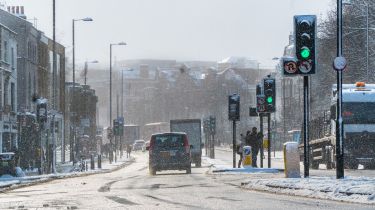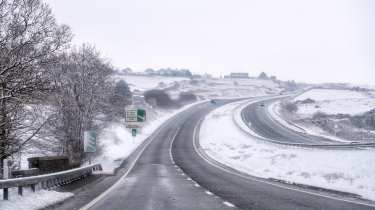How to drive in snow: top tips
Driving in snow can be daunting and dangerous. Our tips will help keep you safe when the white stuff strikes

Winter blizzards usually manage to bring one or more of the UK’s main roads to a halt, and while it’s sometimes snowdrifts that cause the blockage, it can often be drivers how are unsure of how to drive in snow who manage to cause, or at least worsen, the chaos.
If there’s only a light dusting of snow or sleet, the advice is much the same as when driving in icy conditions, but heavier snowfalls – or the threat of them – increase the odds that you may be stranded.
Our advice is to chuck an extra coat or blanket on the back seat for all occupants, and be prepared for the worst. It’s worth having a snow shovel in the boot to help dig your way out of trouble, and plenty of fuel in the tank to keep the engine and heater running if you’re forced to a standstill. Stashing a hot drink in a flask and a couple of energy bars in the glovebox makes a lot of sense on longer journeys, too.
Before you set off, it’s also important to make sure you can see where you’re going. Use a scraper or a brush to clear snow off your windscreen and windows, but don’t be tempted to leave it at that. Snow on your indicators or lamps must be cleared too, and don’t leave snow on the bonnet or roof, because it might fly onto your windscreen or the car behind you as you pick up speed.
An early-morning commute will be much less stressful and dangerous if you give your car a few minutes on the drive to warm up and defrost thoroughly, so you’re not peering through a small clear patch on the windscreen for that first mile or so - especially if it’s still dark. Assuming you live off the main road, just getting to it could be the trickiest part of your journey if snowfalls haven’t been cleared. So if there’s an option to take a gritted or cleared main road instead of your usual shortcut, it may well be sensible to change your route. Pay extra attention to traffic reports before you leave, and during longer journeys to stay out of trouble.
When planning any journey with the risk of extreme winter weather, it’s better to stick to main roads, which will have seen more gritting activity. Not only will they be easier to drive on, but also better patrolled and more accessible for the emergency services.

The downside may be heavier traffic and drivers who are less careful or considerate. You should never feel pressured to drive faster than is sensible in the prevailing conditions, but only move over to let others pass if there’s somewhere obviously safe to go. If there’s only one lane clear on the motorway, don’t drive into a snowdrift just to let people rush by.
During light sleet or snow you should be prepared to control understeer or oversteer skids, but when the white stuff is deeper, you need to adapt your driving style accordingly.
Of course, you will need to drive gently if you are to make good progress without your wheels spinning helplessly. Once you're moving, it's best to keep going and maintain your momentum, because coming to a stop could cause you to get stuck. On the other hand, if you go too fast, you could easily lose control - so be prepared for that, and never drive too close to the car in front.
In heavier snow, and unlike driving on ice, you may find locked wheels slow you more quickly as they dig in and form a snowbank in front of your car. This can be especially helpful if your car starts to slip on a snowy incline, when applying the handbrake and turning the front wheels so they’re side-on to the snow can help stop a runaway.
But do you really want to find out the hard way? When conditions are this bad, the most obvious advice is simply ‘stay at home’.
Driving in snow: 10 top tips
Be prepared
Plan for the worst. Make sure you’ve packed warm clothes, a rug, a torch, a snow shovel and maybe some emergency food. Also, make sure your phone is fully charged before setting off or even have a cheap mobile phone charged and ready to go in the glovebox just in case. Also wear decent driving shoes – driving in snow boots or wellies is a bad idea because it's harder to feel the pedals under your feet. One strong recommendation we would give is to get your car fitted with winter tyres ahead of the cold weather, once the temperature drops consistently into single figures.
Be smooth
When you're driving, avoid sudden applications of the throttle, brakes and steering. If you’re struggling for traction, don’t accelerate excessively – spinning the wheels will only make things worse. Try using second gear to gain traction when pulling away and try to feel grip by slipping the clutch. Some automatic gearboxes offer a winter mode, so try that.
Brake smoothly
When driving on snow-covered slopes, keep your speed slow at the top of the hill. It’s easier to maintain a steady speed than slow down on the descent. Leave big braking distances to vehicles in front – apply the brake pedal gently and avoid triggering the ABS, because the system can struggle to cope if conditions are very slippery. Older cars without ABS may stop sooner, thanks to the locked wheels causing a snowplough effect, in which snow builds up in front of them.
See and be seen
When you start your car, give it plenty of time to warm up, and clear all the snow and ice from your windows and lights - not doing so could be deemed as a traffic offence by the police. If there's a lot of snow on the roof, this should be cleaned off, too, because if it falls off while you're driving it could cause a hazard for other motorists. Ensure your screenwash isn’t frozen and your wipers aren't stuck to your windows. When you're driving, make sure your headlights are on and can be seen by other drivers.
Always plan ahead
Turn your radio on to hear the latest traffic and weather reports, and try to tune into a local station that will have more specific information on the part of the country you’re in. Conditions may not be too bad when you set off, but check ahead for your journey, too. If you don’t have winter tyres, try to avoid routes that have steep inclines and stick to main roads, which are more likely to have been treated.
Know your car’s safety systems
If you’ve got ESP, the stability-control element will help you in a slide. But traction control can sometimes make it hard to get moving in heavy snow. Most cars will allow you to turn off the traction element of the stability control. If you have an auto box, check whether you have a winter mode.
Don’t panic in a slide
If the front wheels start to push across the road, don’t crank on more lock. Ease off the throttle and straighten the steering for a moment to allow the tyres to regain grip. If the rear of the car starts to drift, steer into the slide – known as applying opposite lock. Always look where you want the car to go, because this will help you go in the right direction. Avoid standing on the brakes, because this will only further upset the car, possibly causing it to spin.
Anticipation
In snowy and icy conditions, it takes longer to stop and turn, so reduce your speed and leave lots of extra room between you and the car in front. Watch out for cars around you that may be sliding or losing control. Snow-covered signs and obscured kerbs mean you should pay extra attention to the road infrastructure.
Invest in a course
Nothing takes away the fear of driving in snow more than experiencing it in a controlled environment with expert tuition. Winter driving courses in the Arctic are not cheap, but great fun, and you’ll come away with a host of new skills. If you’re on a tighter budget, a skid-control course based on a wet track or in a car that's fitted to a skid rig is worth doing.
Getting stuck
If you get stuck in snow and are forced to abandon your car, try to move it as far off the road as possible so that you don’t block the way for drivers who are able to continue. If the car starts to slide back down an incline, crank the steering to full lock and apply the handbrake – this will lock the rear wheels, while the fronts will build a bank of snow like a plough, slowing your descent.
Heading out this winter? Be prepared with our winter driving guides...
Get ready for winter on the roads
Top tips for winter driving
Find a car with the experts






